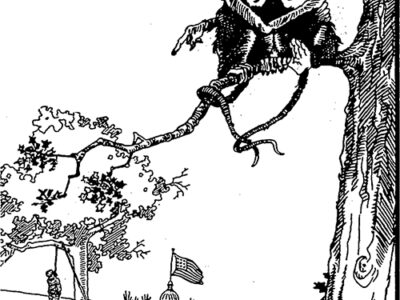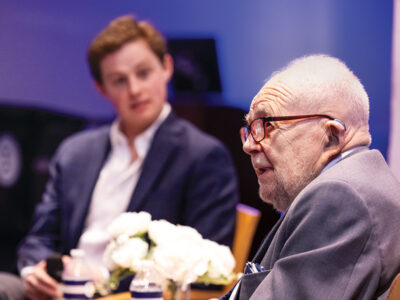
History Professor Kathleen Brown had just given a talk about her latest book, Foul Bodies: Cleanliness in Early America, when a man in tattered, smelly clothes came up to meet her.
The setting was a small museum in New York, and the man, who was homeless, had been stopped at the door. “How ironic is it that I was almost not allowed to come in and hear a talk about a book called Foul Bodies?” he asked.
As they continued to talk, Brown recalls, he “looked me in the eye and said, ‘Do you perceive any bad smell?’” Brown couldn’t admit the truth. She said no.
Although the homeless man may have shown up for the free snacks, he reminded Brown of why she wrote the book, which won the 2010 Levine Award from the Organization of American Historians and was released in paperback by Yale University Press in Feburary.
“We are so used to bodies that leave no traces of themselves through smell,” she says. “We’ve worked so hard to eradicate that quality” that many of us have what we think of as a natural revulsion to certain bodily smells, she adds—even though our ideas about what and who are foul have actually been shaped by centuries of history and culture.
Brown has spent much of her academic career scrutinizing concepts that have often been perceived as natural or inevitable. For example, she is now writing a history of human rights that explores changing definitions of what it means to be human. Her first book, Good Wives, Nasty Wenches, and Anxious Patriarchs, examined views of race formed during slavery. In Foul Bodies, Brown describes how ideas of proper body care developed over centuries of contact between peoples in the Atlantic world and were intertwined with disease prevention, class identity, and spiritual purity. She shows how women, historically labeled the fouler sex, played a critical role in “civilizing” bodies—as laundresses, wives and mothers, and social reformers.
Tracing the history of our current obsession with daily showers and antibacterial wipes is not as simple as it may seem. What Brown didn’t find was some straightforward march from a time when the air was scented by stale chamber pots and scurvy breath to the hyper-sanitation of today.
“There is this vision of the past that my students often have—and I always try to shake them out of the idea—that people in the past knew something was bad and were just hoping it would get better like it is today,” Brown says. But history, she argues, isn’t imbued with such a natural momentum.
Bathing, for instance, was a popular practice in medieval Europe until plague fears and bawdy reputations shut down public baths in the 16th century. Over the next couple of centuries, only a small minority of health practitioners immersed themselves in water. Most believed that it upset the equilibrium and opened pores, putting the body at greater risk for disease.
Before bathing made a comeback in the 19th century, Europeans and their American counterparts kept clean by changing the long shirts they wore next to their bodies. (The fabric absorbed some odors.) The white linen shirt, worn so it would peek through the outer-garments, also came to symbolize the skin, “standing for your position in life, for your respectability, for your refinement,” Brown says. (In contrast, the “uncivilized” Native Americans and West Africans that European explorers met went shirtless.) Those with the means to have shirts washed regularly “wanted everybody to know about it, like Madonna wearing her underwear on the outside,” Brown says. Women’s work—sewing and cleaning clothes—made this possible; by the end of the 18th century, Monday had become a regular laundry day in many households.
In an era of increasing travel, attention to grooming allowed one to make quick, if not always accurate, judgments, about the people one met, Brown explains. Elite men led the way, serving up snarky commentaries about others’ habits. In a letter to his nieces, for instance, John Adams claimed he would dip his own daughters in a boiling kettle for cleaning “if ever I find them half so nasty as I have seen some [British ladies].”
But new cleaning practices also grew out of health concerns. Before germ theory was established, many people linked public filth to diseases like smallpox and yellow fever, which had ravaged many American cities in the 18th century. Medical-advice books urged people to air out their homes, whitewash walls with lime, and bathe regularly. According to Brown, “The things that people might do in daily life that might protect against [disease] strangely become a part of how people define their position as part of the emerging middle class.”
Anxious to keep their families healthy and to differentiate themselves from the less refined, women became the chief enforcers of cleanliness in their households in the 19th century. “How people judged you and your children had to do with how you prepared them to go out into public,” Brown says. Mothers also joined the ranks of reformers who tried to bring new standards to the public, particularly the poor. By cleaning their bodies, reformers reasoned, the poor could lift themselves out of moral squalor and take up roles as industrious citizens.
Brown calls today’s body-care regimes “obsessive by 19th-century standards,” noting that “in the sanitized corporate workplace, there is no place for curly hair, never mind facial hair (especially on women), bad teeth, or body odor.”
That’s not to say this trend will prevail. Much as she loves the just-showered feeling “as a way to mark the start of the day,” Brown recognizes that it mainly serves a ritual purpose. She is interested in the environmental movement to get by on fewer showers. In the future, she suggests, water scarcity may force others to reconsider their grooming habits, which will “present an interesting dilemma for people in the United States, who are so inflexible about what it takes to be clean enough to enter public spaces.”
For many, the homeless man Brown met would not pass muster. But as she continued to listen to him, he told her he had once gotten a degree in pharmacy. He used to have the money to eat in restaurants, and now he wasn’t even allowed to use their bathrooms. What was he supposed to do?
“He said, ‘I want to tell you how proud I am that you wrote this book.’ I was almost teary,” Brown says, “because he just insisted on being a full human being.”
—Susan Frith




